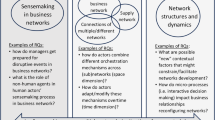Abstract
Focusing on the type of consumer expectations, i.e., passive and responsive expectations, we reconsider the excess entry theorem in the case of Cournot oligopoly with network externalities. We demonstrate that whether the number of firms under free entry is socially excessive or insufficient depends on the type of consumer expectations and the degree of network externalities. That is, in the case of passive expectations, if the degree of network externalities is sufficiently large (small), the number of firms under free entry is socially insufficient (excessive), based on the second-best criteria. However, in the case of responsive expectations, the number of firms under free entry is socially excessive, based on the second-best criteria.
Similar content being viewed by others
Notes
See Berry and Waldfogel (1999), who empirically investigated whether free entry is socially inefficient in US radio broadcasting.
Using a spatial competition model, Matsumura and Okamura (2006) showed that the excess entry theorem holds under price competition.
We ignore the integer constraint on the number of firms, as has been done in most previous studies.
In our model, the expected network size is connected to the total output in the market and not the number of consumers and users. For example, we assume that the expected network size is related to either the number of times of use of an Internet service or the sales quantities of a smartphone.
We derive the following changing rate of an equilibrium output by an increase in the number of firms: \(\varepsilon^{p} (\phi ) \equiv - \frac{{dq^{p} }}{dn}\frac{n}{{dq^{p} }} = \frac{(1 - \phi )n}{(1 - \phi )n + 1} < 1\) and \(\varepsilon^{r} \equiv - \frac{{dq^{r} }}{dn}\frac{n}{{dq^{r} }} = \frac{n}{n + 1} < 1\) where \(\varepsilon^{p} (\phi = 0) = \varepsilon^{r}\) and \(\frac{{d\varepsilon^{p} (\phi )}}{d\phi } < 0.\) In the case of passive expectations, the larger the degree of network externalities, the lower the changing rate. However, in the case of responsive expectations, the changing rate is independent of the degree of network externalities.
We outline the case of a general function in the Appendix.
Mukherjee and Mukherjee (2008) demonstrated that in the presence of technology licensing, entry in an industry with Cournot competition may lead to a socially insufficient number of firms.
References
Berry, S. T., & Waldfogel, J. (1999). Free entry and social inefficiency in radio broadcasting. The RAND Journal of Economics,30(3), 397–420.
Economides, N. (1996). Network externalities, complementarities, and invitations to enter. European Journal of Political Economy,12, 211–233.
Hurkens, S., & López, A. L. (2014). Mobile termination, network externalities and consumer expectations. Economic Journal,124, 1005–1039.
Kagitani, K., Ohkawa, T., & Okamura, M. (2016). Does the excess entry theorem hold in a differentiated oligopoly? The Manchester School,84(3), 340–362.
Katz, M., & Shapiro, C. (1985). Network externalities, competition, and compatibility. American Economic Review,75(3), 424–440.
Mankiw, G. N., & Whinston, M. D. (1986). Free entry and social inefficiency. RAND Journal of Economics,17(1), 48–58.
Matsumura, T., & Okamura, M. (2006). A note on the excess entry theorem in spatial markets. International Journal of Industrial Organization,24, 1071–1076.
Mukherjee, A., & Mukherjee, S. (2008). Excess-entry theorem: The implications of licensing. The Manchester School,76(6), 675–689.
Shubik, M., & Levitan, R. (1980). Market Structure and Behavior. Cambridge: Harvard University Press.
Suzumura, K. (2012). Excess entry theorems after 25 years. Japanese Economic Review,63(2), 152–170.
Suzumura, K., & Kiyono, K. (1987). Entry barriers and economic welfare. Review of Economic Studies,54(1), 157–167.
Author information
Authors and Affiliations
Corresponding author
Additional information
Publisher's Note
Springer Nature remains neutral with regard to jurisdictional claims in published maps and institutional affiliations.
Appendix: Excess entry theorem in a general function case
Appendix: Excess entry theorem in a general function case
We assume the surplus function of a representative consumer in a homogeneous product market with network externalities as follows: \(V = U(Q,F(S^{E} )) - PQ\). Thus, an inverse demand function with network externalities is given by:
In the following sections, we generally consider the excess entry theorem in the cases of passive and responsive expectations.
1.1 The case of passive expectations
Given Eq. (24), the profit function of firm i is expressed as: \(\pi_{i} = P(Q,F(S^{E} ))q_{i} ,\quad i = 1, \ldots ,n\). Firm i determines the output to maximize the profit, given the other firms’ outputs and expected network sizes by consumers. The FOC is given by:
In a fulfilled and symmetric equilibrium, i.e.,\(S^{E} = Q\) and \(q_{i} = q_{ - i} = q^{p} ,\quad i, - i = 1, \ldots ,n,i \ne - i\) Eq. (25) can be rewritten as:
where \(Q^{p} = nq^{p} (n)\).
From Eq. (24), the welfare function with network externalities based on the second-best criteria can be represented by:
Given Eq. (27), the socially second-best number of firms is given by: \(n^{p*} = \arg \hbox{max} W^{p} (n)\). In particular, the FOC is given by:
where \(P^{p} \equiv P\left( {Q^{p} ,F(Q^{p} )} \right)\), \(\frac{\partial P}{\partial F} = \frac{\partial P}{\partial F}\left( {X,F(Q^{p} )} \right)\), and \(\frac{{\partial Q^{p} }}{\partial n} = q^{p} + \frac{{\partial q^{p} }}{\partial n}n\).
Using Eq. (28) and the zero-profit condition, we obtain the following equation:
Following the terminology of Mankiw and Whinston (1986), the first term in Eq. (29) is a business-stealing effect and the second a business-augmenting effect by network externalities. Thus, in general, we obtain the following relationship:
Equation (30) is a general condition to prove whether the number of firms under free entry is socially excessive or not, based on the second-best criteria. For example, as in the text, assuming a linear inverse demand function with an additively separable and linear network function, i.e., \(\frac{\partial P}{\partial F} = 1\) and \(\frac{\partial F}{{\partial Q^{p} }} = \phi\), we obtain Eq. (20).
1.2 The case of responsive expectations
In this case, because it holds that \(S^{E} = Q\), Eq. (24) can be revised as follows: \(P = P(Q,F(Q))\). The profit function of firm i is expressed as: \(\pi_{i} = P(Q,F(Q))q_{i} ,\quad i = 1, \ldots ,n\). In this case, firms in the market take expected network sizes by consumers into account in advance, given the other firms’ outputs. Thus, the FOC is given by:
In a symmetric equilibrium, i.e., \(q_{i} = q_{ - i} = q^{r} ,\quad i, - i = 1, \ldots ,n,i \ne - i\), Eq. (31) can be rewritten as:
where \(Q^{r} = nq^{r} (n)\).
By a similar procedure in the case of passive expectations, the welfare function with network externalities based on the second-best criteria can be represented by:
Given Eq. (33), the socially second-best number of firms is given by: \(n^{r*} = \arg \hbox{max} W^{r} (n)\). In particular, the FOC is given by:
where \(P^{r} \equiv P\left( {Q^{r} ,F(Q^{r} )} \right)\) and \(\frac{{\partial Q^{r} }}{\partial n} = q^{r} + \frac{{\partial q^{r} }}{\partial n}n\).
Using Eq. (30) and the zero-profit condition, we obtain the following equation:
where \(P^{r} \frac{{\partial q^{r} }}{\partial n}n\) expresses a business-stealing effect. That is, Eq. (35) shows that the excess entry theorem generally holds in the case of responsive expectations, irrespective of the presence of network externalities. As in the text, assuming a linear inverse demand function, i.e., Eq. (5), we obtain Eq. (23).
Rights and permissions
About this article
Cite this article
Toshimitsu, T. Note on the excess entry theorem in the presence of network externalities. J. Ind. Bus. Econ. 47, 271–282 (2020). https://doi.org/10.1007/s40812-020-00151-0
Received:
Revised:
Accepted:
Published:
Issue Date:
DOI: https://doi.org/10.1007/s40812-020-00151-0
Keywords
- Excess entry theorem
- Cournot oligopoly
- Free entry
- Network externality
- A fulfilled equilibrium
- Passive expectations
- Responsive expectations




